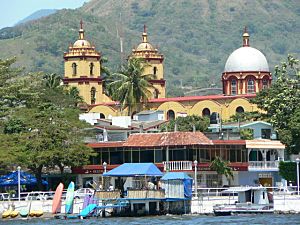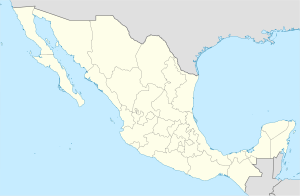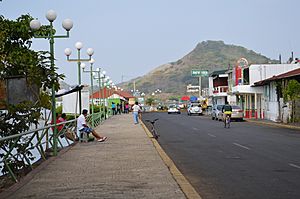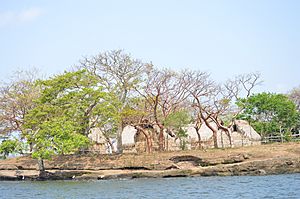Catemaco facts for kids
Quick facts for kids
Catemaco
|
||
|---|---|---|
|
City and municipal seat
|
||

Catemaco seen from the lake
|
||
|
||
| Country | ||
| State | Veracruz | |
| Municipality | Catemaco | |
| Founded | 1774 | |
| Declared city | 1966 | |
| Elevation | 340 m (1,116 ft) | |
| Population
(2010)
|
||
| • Total | 27,615 | |
| • Municipality | 48,593 | |
| Time zone | UTC-6 (Central Standard Time) | |
| Postal code |
95870
|
|
| Area code(s) | 294 | |
Catemaco is a city in the southern part of the Mexican state of Veracruz. It is the main city for the municipality of the same name. The city sits right on Lake Catemaco, and the wider municipality reaches all the way north to the Gulf of Mexico.
Catemaco is a popular place for tourists. People come to see its beautiful lake, the remains of its rainforest, and its unique tradition of ancient practices. These traditions have roots in the time before Mexico was colonized. They are mostly practiced by men and are well-known across Mexico. Many people, including business leaders and politicians, visit Catemaco for these practices. The city even hosts a special event each March dedicated to these traditions, which can attract up to 5,000 visitors!
Contents
Exploring the City of Catemaco
The city of Catemaco is in southern Veracruz. It's about 160 kilometers (100 miles) from the port of Veracruz. The city stretches for 2.5 kilometers (1.5 miles) along the shore of Lake Catemaco. This large freshwater lake is one of the city's main attractions. Visitors also enjoy the local food and the city's special traditions.
Along the lake, there's a 1.5-kilometer (1-mile) long walkway called a breakwater or boardwalk. This area is often busy with both visitors and local sellers. You might find people selling good luck charms or a local freshwater snail called tegogolo. The city's docks are in the middle of this area. They are used for both fishing and tourism. Most boats here are for tourists, especially during holidays.
Main Plaza and Basilica
Another important part of the city is the main plaza. It's a popular spot for both locals and tourists. The most important building here is the Basilica of Our Lady of Mount Carmel. People started honoring this version of the Virgin Mary a long time ago, in the early colonial period. It replaced the local worship of Chalchiuhtlicue, who was the goddess of water and fishermen.
This basilica has a special image of Our Lady of Mount Carmel. Many people believe this image has caused miracles. Its importance is only matched by a shrine on an island in Lake Catemaco called El Tegal. People say the Virgin Mary appeared there. The current church building was started in 1799 but wasn't finished until 1961. The church mixes two old building styles: Baroque and Neoclassical. It has a dome that is 21 meters (69 feet) high. The colorful stained glass windows around it show scenes from the lives of Jesus and Mary.
Every year, there's a big celebration for Our Lady of Mount Carmel at this basilica. It includes a boat parade to Agaltepec Island. You can also hear traditional music like danzón, Son Jarocho, and other tropical tunes. Musicians play guitars, violins, the vihuela, and double bass.
Other City Sights
Other interesting places in Catemaco include the Statue of the Fisherman and the Torre del Reloj (Clock Tower). There are also historic homes like the Brizuela Absalón House and the Gasca Blanco House. The Casa de los Tesoros is a big gift shop. Here, you can find local crafts and tasty treats like bagels and bizcochos.
The city also has a bus station. From here, you can travel to the ports of Veracruz and Coatzacoalcos.
Catemaco's Special Traditions
Catemaco is famous in Mexico for its community of brujos and brujas. These words can mean 'wise people' or 'healers' who practice ancient traditions. Most of them are men, but some are women. These special practices have been part of Catemaco's history since before the Spanish arrived. They might have survived because the area was quite isolated. People also say that Lake Catemaco and the Mono Blanco Mountain nearby give off a special kind of energy.
These traditions blend Catholic customs, like praying to saints, with older beliefs and rituals. While some tourists just enjoy the fun souvenirs, others take these practices very seriously. There are practitioners of "white" traditions, which are more widely accepted, and others who practice "black" traditions, which are less common and often cost more.
These ancient practices are one of Catemaco's main attractions. People from all walks of life visit, from waiters and taxi drivers to important politicians. For example, a former governor of Veracruz, Fidel Herrera Beltrán, even tried to start a national school for these practices in Catemaco. He is also a regular visitor at the annual event. Visitors often seek limpias (ritual cleansings), healing, or help with their businesses. These practices have also spread as people from Catemaco move to other cities like Ciudad Juárez.
Annual Gathering of Practitioners
The main event for these practitioners is the annual Congreso Nacional de Brujos de Catemaco. It's officially called the Ritos, Ceremonias y Artesanías Mágicas (Rituals, Ceremonies, and Magical Crafts) because of concerns from the Catholic Church. The main part of the event happens on the first Friday of March. It used to start with a "black mass" at midnight by the "brujo mayor" (head practitioner) near Lake Catemaco. This event could draw up to 5,000 people.
More recently, this large public ceremony has been replaced by private ceremonies. Each main practitioner holds their own ceremony on their property. The next afternoon, there's a public parade where each practitioner and their followers walk through the town. This ends with a public celebration that includes traditional dance. This event started in the 1970s. Today, it brings together about 200 shamans, healers (curanderos), herbalists, psychics, and fortune tellers. It also brings a lot of money, up to three million pesos, to the local economy.
The popularity of these practitioners and the event has also created some challenges. Some dishonest people have tried to trick visitors, making it hard to find genuine practitioners. There have also been disagreements among the practitioners about clients, tourism, and who should lead the ceremonies at the annual gathering.
Catemaco's Past
In ancient times, the Olmec people lived in this area. The name Catemaco comes from the Nahuatl language. It might mean "place of the burned houses," possibly referring to a volcano eruption. However, some language experts say this meaning is not grammatically correct in Nahuatl. Another idea is that it means "at the place where boats are loaded."
Starting in the 1500s, the area was part of the Santiago Tuxtla province. After Mexico became independent, it became a municipality. The city of Catemaco itself was founded in 1774. In 1881, it officially became a town, and in 1966, it was declared a city.
See also
 In Spanish: Catemaco para niños
In Spanish: Catemaco para niños






